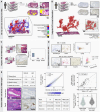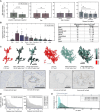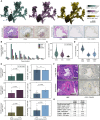This is a preprint.
3D histology reveals that immune response to pancreatic precancers is heterogeneous and depends on global pancreas structure
- PMID: 39149369
- PMCID: PMC11326156
- DOI: 10.1101/2024.08.03.606493
3D histology reveals that immune response to pancreatic precancers is heterogeneous and depends on global pancreas structure
Abstract
Pancreatic ductal adenocarcinoma (PDAC) is a highly lethal cancer for which few effective therapies exist. Immunotherapies specifically are ineffective in pancreatic cancer, in part due to its unique stromal and immune microenvironment. Pancreatic intraepithelial neoplasia, or PanIN, is the main precursor lesion to PDAC. Recently it was discovered that PanINs are remarkably abundant in the grossly normal pancreas, suggesting that the vast majority will never progress to cancer. Here, through construction of 48 samples of cm3-sized human pancreas tissue, we profiled the immune microenvironment of 1,476 PanINs in 3D and at single-cell resolution to better understand the early evolution of the pancreatic tumor microenvironment and to determine how inflammation may play a role in cancer progression. We found that bulk pancreatic inflammation strongly correlates to PanIN cell fraction. We found that the immune response around PanINs is highly heterogeneous, with distinct immune hotspots and cold spots that appear and disappear in a span of tens of microns. Immune hotspots generally mark locations of higher grade of dysplasia or locations near acinar atrophy. The immune composition at these hotspots is dominated by naïve, cytotoxic, and regulatory T cells, cancer associated fibroblasts, and tumor associated macrophages, with little similarity to the immune composition around less-inflamed PanINs. By mapping FOXP3+ cells in 3D, we found that regulatory T cells are present at higher density in larger PanIN lesions compared to smaller PanINs, suggesting that the early initiation of PanINs may not exhibit an immunosuppressive response. This analysis demonstrates that while PanINs are common in the pancreases of most individuals, inflammation may play a pivotal role, both at the bulk and the microscopic scale, in demarcating regions of significance in cancer progression.
Keywords: PanIN; Pancreatic cancer; inflammation; precancers; tumor heterogeneity.
Figures





References
-
- Morton D.L., Eilber F.R., Malmgren R.A., and Wood W.C. (1970). Immunological Factors Which Influence Response to Immunotherapy in Malignant Melanoma. Surgery 68, 158-&. - PubMed
-
- Chen R., Zinzani P.L., Fanale M.A., Armand P., Johnson N.A., Brice P., Radford J., Ribrag V., Molin D., Vassilakopoulos T.P., et al. (2017). Phase II Study of the Efficacy and Safety of Pembrolizumab for Relapsed/Refractory Classic Hodgkin Lymphoma. Journal of Clinical Oncology 35, 2125–+. 10.1200/Jco.2016.72.1316. - DOI - PMC - PubMed
Publication types
Grants and funding
LinkOut - more resources
Full Text Sources
